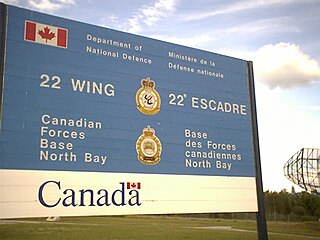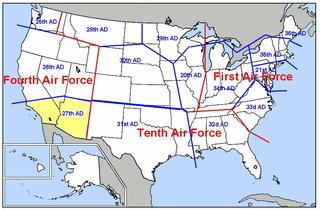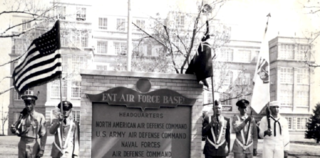Related Research Articles

The Semi-Automatic Ground Environment (SAGE) was a system of large computers and associated networking equipment that coordinated data from many radar sites and processed it to produce a single unified image of the airspace over a wide area. SAGE directed and controlled the NORAD response to a possible Soviet air attack, operating in this role from the late 1950s into the 1980s. Its enormous computers and huge displays remain a part of cold war lore, and after decommisioning were common props in movies such as Dr. Strangelove and Colossus, and on science fiction TV series such as The Time Tunnel.

North American Aerospace Defense Command, known until March 1981 as the North American Air Defense Command, is a combined organization of the United States and Canada that provides aerospace warning, air sovereignty, and protection for Canada and the continental United States. Headquarters for NORAD and the NORAD/United States Northern Command (USNORTHCOM) center are located at Peterson Space Force Base in El Paso County, near Colorado Springs, Colorado. The nearby Cheyenne Mountain Complex has the Alternate Command Center. The NORAD commander and deputy commander (CINCNORAD) are, respectively, a United States four-star general or equivalent and a Canadian Lieutenant-general or equivalent.

Aerospace Defense Command was a major command of the United States Air Force, responsible for continental air defense. It was activated in 1968 and disbanded in 1980. Its predecessor, Air Defense Command, was established in 1946, briefly inactivated in 1950, reactivated in 1951, and then redesignated Aerospace rather than Air in 1968. Its mission was to provide air defense of the Continental United States (CONUS). It directly controlled all active measures, and was tasked to coordinate all passive means of air defense.

The AN/FSQ-32 SAGE Solid State Computer was a planned military computer central for deployment to Super Combat Centers in nuclear bunkers and to some above-ground military installations. In 1958, Air Defense Command planned to acquire 13 Q-32 centrals for several Air Divisions/Sectors.

The 26th Air Division is an inactive United States Air Force organization. Its last assignment was with Air Defense Tactical Air Command, assigned to First Air Force, being stationed at March Air Force Base, California. It was inactivated on 30 September 1990.

The 27th Air Division was a United States Air Force numbered air division and the geographic Air Defense Command region controlled by the 27th AD. Its last assignment was with Air Defense Command (ADC)'s Tenth Air Force, at Luke Air Force Base, Arizona. It was inactivated on 19 November 1969.
Thomasville Air Force Station is a closed United States Air Force General Surveillance Radar station. It is located 1.9 miles (3.1 km) north-northwest of Thomasville, Alabama. It was closed in 1969.

The Great Falls Air Defense Sector (GFADS) is an inactive United States Air Force organization. Its last assignment was with the Air Defense Command 29th Air Division, being stationed at Malmstrom Air Force Base, Montana. It was inactivated on 1 April 1966.

Finland Air Force Station is a closed United States Air Force General Surveillance Radar station. It is located 2.8 miles (4.5 km) north of Finland, Minnesota. It was closed in 1980.

The Chidlaw Building is a former United States Air Force facility located in the Knob Hill neighborhood of Colorado Springs, Colorado. The building was close to, but not within, the Ent Air Force Base complex, and was leased by the military for several decades, housing headquarters for several military commands, starting with the Air Defense Command (ADC) and the North American Aerospace Defense Command (NORAD). When Chidlaw was completed, personnel from multiple locations, including the Ent Air Force Base, were consolidated into the new building.
Backup Interceptor Control was the Electronic Systems Division 416M System to backup the SAGE 416L System in the United States and Canada. BUIC deployed Cold War command, control, and coordination systems to SAGE radar stations to create dispersed NORAD Control Centers.
Ground Air Transmit Receive (GATR) control sites were the radio stations of a Cold War communications network in the Burroughs 416L SAGE Defense System deployed to automate ground-controlled interception using manned interceptors. Generally located near or, in some cases, on an Aerospace Defense Command radar station, a GATR site was used for the Ground to Air Data Link Subsystem to communicate command guidance via HF/VHF/UHF voice and TDDL to vector F-106 Delta Dart and other suitably equipped aircraft that had been dispatched by teams in Weapons Direction rooms of SAGE Direction Centers. Maintenance was done by the 304x4 Ground Radio Maintenance career field, with initial technical training at Keesler Air Force Base. The sites included the RCA AN/GKA-5 Time Division Data Link (TDDL) equipment, that fed a two-channel AN/FRT-49 Electronic Guidance Signals Transmitting Set, employing Varian klystrons to deliver 20 kilowatts output power (early sites used the 100 watt, single-channel AN/GRT-3 instead. The aircraft receivers were either Hughes AN/ARR-60 or SLI AN/ARR-61 Airborne Radio Receivers of the Hughes MA-1 Fire Control System.

The Fort Heath radar station was a USAF radar site and US Army Missile Master installation of the joint-use site system (JUSS) for North American Air Defense at a former coastal defense site. The Cold War radar station had 2 USAF AN/FPS-6B height finding radars, 2 Army AN/FPS-6A height finders, an FAA ARSR-1 radar emplaced 1958-9, and an Army nuclear bunker. Arctic Towers were the pedestals for the FPS antennas and radomes, while the Air Route Surveillance Radar was on a 50-foot extension temperate tower adjacent to the Federal Aviation Administration building.
The GE AN/GPA-73 Radar Course Directing Group was a US Cold War air defense command, control, and coordination system developed for the Electronic Systems Division 412L Air Weapons Control System for weapons direction. The AN/GPA-73 was used to create a "Base Air Defense Ground Environment", for which Air Defense Command had recommended the system as "SAGE back-up control of BOMARC" in June 1958. When the GPA-73 was emplaced with the AN/FSA-21 Weapons Control Group computer for GCI, the system created a "miniature SAGE" military installation. The GPA-73 could also direct Project Nike surface-to-air missile fire from Nike Integrated Fire Control sites equipped with the "412 Target Designation System" in the Battery Control Van in a space allocated by February 1957 "behind the Acquition Operator [sic]". and the AN/GPA-73.

A Super Combat Center (SCC) was a planned Cold War command and control facility for ten NORAD regions/Air Divisions in Canada and the United States. For installation in nuclear bunkers, the command posts were to replace the last of the planned Air Defense Command Combat Centers to be built for vacuum tube AN/FSQ-8 Combat Control Centrals. The survivable SCCs were to use solid-state (transistorized) AN/FSQ-32 equipment which was to provide the Semi-Automatic Ground Environment for operators at 10 Air Divisions — 5 of the centers were to also serve as Air Defense Direction Centers ("SCC/DCs") for commanding ground-controlled interception in sectors of the 27th, 30th, 32nd, 33rd, and 35th Air Divisions. ADC's November 1958 plan to complete the hardened SCCs by April 1964 included fielding 3 additional AN/FSQ-32 systems above-ground for the Albuquerque, Miami, and Shreveport sectors.
An Air Defense Direction Center (ADDC) was a type of United States command post for assessing Cold War radar tracks, assigning height requests to available height-finder radars, and for "Weapons Direction": coordinating command guidance of aircraft from more than 1 site for ground-controlled interception. As with the World War II Aircraft Warning Service CONUS defense network, a "manual air defense system" was used through the 1950s Along with 182 radar stations at "the end of 1957, ADC operated … 17 control centers", and the Ground Observation Corps was TBD on TBD. With the formation of NORAD, several types of ADDCs were planned by Air Defense Command:

The Denver Air Defense Sector was a United States Air Force geographic area designated during the Cold War for both air defense and air traffic control, as well as the name of the planned military unit for conducting radar surveillance and fighter-interceptor operations in the sector area. The Denver ADS spanned the entire state of Colorado, nearly all of Utah, most of Wyoming and western Nebraska, and small parts of Kansas, Oklahoma, New Mexico, Arizona, and Nevada. Potential targets in the sector included the military/industrial facilities and urban civilian populations of the metropolitan areas at Salt Lake City, Cheyenne, Denver, and Colorado Springs..
NORAD Control Centers (NCCs) were Cold War "joint direction centers" for command, control, and coordination of ground-controlled interception by both USAF Air Defense Command (ADC) and Army Air Defense Command (ARADCOM). The Joint Manual Steering Group was "formed by the Army and Air Force in July 1957 to support…collocation" of USAF Air Defense Direction Centers and Army Air Defense Command Posts, which began after a January 28, 1958, ADC/ARADCOM meeting with NORAD to "collocate the Fairchild-Geiger facilities" Army contracts for 5 NCCs had been let by August 17, 1958, after 1956 DoD approval for collocation of interim "pre-SAGE semiautomatic intercept systems" and radar squadrons at 10 planned Army Missile Master AADCPs

Continental Air Defense Command (CONAD) was a Unified Combatant Command of the United States Department of Defense, tasked with air defense for the Continental United States. It comprised Army, Air Force, and Navy components. It included Army Project Nike missiles anti-aircraft defenses and USAF interceptors. The primary purpose of continental air defense during the CONAD period was to provide sufficient attack warning of a Soviet bomber air raid to ensure Strategic Air Command could launch a counterattack without being destroyed. CONAD controlled nuclear air defense weapons such as the 10 kiloton W-40 nuclear warhead on the CIM-10B BOMARC. The command was disestablished in 1975, and Aerospace Defense Command became the major U.S. component of North American Air Defense Command (NORAD).

The Missile Warning Center (MWC) is a center that provides missile warning and defense for United States Space Command's Combined Force Space Component Command, incorporating both space-based and terrestrial sensors. The MWC is located at Cheyenne Mountain Space Force Station.
References
*"General Partridge replied on 2 July 1959 that the NORAD requirement for a non-SAGE back-up method of exercising operational control of all weapons was valid until the SCC system was operational and could not be withdrawn. [11]
**NCCs were at Missile Masters for "the Los Angeles, Seattle, Chicago, Detroit, Boston, Washington-Baltimore, New York, and Buffalo areas. NORAD added San Francisco, at which there was no NCC, but at which, NORAD said, one would be established. ... NORAD required an AN/GPA-67 at each of these NCC's so as to provide a capability for control of Time Division Data Link-equipped interceptors when the sector converted to TDDL." [11]
- 1 2 http://airforcehistoryindex.org/data/000/463/903.xml IRISNUM 00463903
- ↑ http://airforcehistoryindex.org/data/000/465/779.xml "Installation of AN/GPA-37 Automatic Ground Controlled Interception"
- 1 2 "Automatic G.C.I." Flight Global: 618 & p. 619. May 10, 1957.
- 1 2 Division 6 - Lincoln Laboratory...Biweekly Report for 29 July 1955 (Memorandum 6M-3797) A symposium on the AN/GPA-37 system was held at Rome Air Development Center on 26 and 27 July. This system Involves a technique for ground control of interceptors by use of the Tracker-Computer (AN/GPA-23), which was developed at Columbia University. Field tests on this system will begin in November 1955; It would be worthwhile to follow the activ- ities of these field tests. ... The Systems Office has obtained more detailed information about the Radar Course Directing Group, AN/GPA-37, at a symposium held at RADC on 26 and 27 July. The GPA-37 is intended for backup air defense for SAGE and will be operated at the Heavy Radar P-sites in the Zone of Interior
- 1 2 3 4 NORAD/CONAD Historical Summary: July–December 1958 "In September 1956, CONAD proposed to the JCS the collocation of the Missile Master and the Air Force's AN/GPA-37 in ten areas. The Office of the Secretary of Defense concurred on 30 October 1956."
- ↑ Condit, Kenneth W. (1992) [1971]. "Chapter 15: Continental Defense". The Joint Chiefs of Staff and National Policy: 1955-1956 (Report). Vol. VI of History of the Joint Chiefs of Staff. Washington, DC: Historical Office, Joint Staff.
c. Modify existing manual aircraft control and warning system so that it will have the capacity to handle a mass raid by completing installation of interim equipment (AN/GPS-T2 and AN/GPA-37).
- ↑ McMullen, R. F. (15 February 1980). History of Air Defense Weapons 1946–1962 (Report). Vol. ADC Historical Study No. 14. Historical Division, Office of information, HQ ADC. pp. 211, 306.
the GPA-37 electronic heart of an advanced system of ground controlled interception which immediately preceded SAGE, and with SAGE itself. ... The AN/GPA-35[ sic ] was a pre-SAGE control system that would be used until SAGE was ready.
- ↑ Preface by Buss, L. H.--NORAD Director of Command History (1 October 1958). North American Air Defense Command Historical Summary: January — June 1958 (8 chapters & Appendix) (Report). Directorate of Command History: Office of Information Services. p. 21. Retrieved 2013-04-10.
- ↑ NORAD CONAD Historical Summary: January–June 1959 " Both CAA and AMB were incorporated in a new agency, the Federal Aviation Agency which officially began functioning on 31 December 1958 ... RCAF would be responsible for constructing the Ottawa SCC building and for insuring a beneficial occupancy date of 15 September 1961. The AN/FSQ-7A computer would be installed by IBM and by late 1962 RCAF personnel would man the SCC under the direction of the responsible test agencies. The SCC was scheduled to become fully operational on 1 July 1963. ... On 17 July 1959, USAF directed the BMEWS Project Office to prepare an engineering proposal for an interim BMEWS display facility. ... In a paper dated 11 February 1959, the JCS charged the Air Force Chief of Staff with responsibility for the [Cheyenne Mountain] COC project. ... site A, Cheyenne Mountain, in the "NORAD Site Investigation Feasibility Report," dated January 1959, prepared by the firm of Parsons, Brinckerhoff, Hall und MacDon ald for the Army Corps of Engineers. ... The esti mated construction cost of the NORAD COC installation is $28,540,000. ... 19 May 1959 on re quirements of the NORAD Command Control System. ... National Space Surveillance Control Center...7 January with a directive to ARDC to build a research and development interim NSSCC at Han scom Field, Massachusetts. ... At NORAD Headquarters, a space surveillance control center committee was established on 12 February 1959. ... Maintain liaison with the ARDC Space Detection and Surveillance Filter Center being established at Laurence G. Hanscom Field ... ARDC Space Detection and Surveillance Filter Center being established at Laurence G. Hanscom Field ... "
- ↑ "General Discussion - Roll Call (1344 views)". December 28, 2012.
- 1 2 NORAD CONAD Historical Summary: July–December 1959 "On 18 March 1960, the JCS advised NORAD that they had approved cancellation of the SCC program for the U.S."